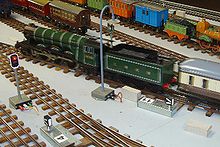Drive systems of the model railway
The drives of the model railways have changed a lot since their first rounds on oval tracks and have always been based on the latest technology. The drive and the options for controlling the model are often technically dependent on one another.
Mechanically
Rolling models
These models are simply pushed over the tracks by hand. The best-known example is the wooden track , which was developed by the manufacturer Brio . The very first locomotives in nominal size N were also such motorless rolling models.
clockwork
Early on, the models for the toy market were driven by a wind-up clockwork , i.e. a tensioned spring . This made it difficult to control them from the outside, but the models were built robustly so that they could withstand the switches being gripped at full speed. There were also slow-travel and stop tracks that took control of the locomotive and could safely stop it. Such a clockwork-driven railway system, the Billerbahn , was built and sold in Germany until the 1970s.
combustion
steam
When the prototype also ran on steam, models powered by steam were also built. Here, real firing (gas, alcohol, Esbit, but also coal) converts water into steam and thus drives one or more cylinders. Historical specimens are now collector's items; In the larger scales ( nominal sizes 1 and 2 ) there is again a noteworthy range of finished locomotives and kits with steam operation. Even in size H0 , live steam models are occasionally built in series; However, the very filigree models are designed more for the showcase than for everyday use. The annual real steam meeting in the Auto- und Technikmuseum Sinsheim offers an overview of the scene .
Petrol and diesel
Powerful combustion engines have been developed for model aircraft and cars, so that there have also been attempts to make them usable for model locomotives . Mostly, based on the diesel-electric model, the engine drives a generator, which then supplies the electricity to operate an electric motor. In analogy to real steam, this type of drive is referred to as real diesel , even if diesel is not used as fuel.
Electric
The electric drive is by far the most frequently used technology today. At the time of its creation, running a model railway with batteries or accumulators built into the locomotives was out of the question for reasons of space. So the method known today of the electric drive with a power supply through the running rails developed immediately, which at the same time allows a developed control of the models.
At the beginning the locomotives were operated with alternating current and corresponding all-current motors were used; It was only after the Second World War that direct current caught on. In the H0 size, which is the most widespread in Germany, both types of current are still used today.
Engines
The electric motor is basically the most important design problem of a model railway locomotive, as it has to be powerful, easy to control and at the same time as small as possible. For many years, the engines used by the large companies have remained the same, even for the most varied types of locomotives. For example, until the early 1970s, Märklin used a three-pole motor with a spur gear, which is generally referred to as a disc collector motor because of its design . In the mid-1970s to around the end of the 1990s, it was replaced by the so-called drum collector motor , for which there was also a special form with a five-pole armature for digital models (the so-called high - performance motor ).
Other companies began in the 1960s to install the engine in the tender instead of the locomotive itself, due to lack of space . Where this was not possible, the three-pole so-called round motor was used, which was replaced in the mid-1990s by a central motor with a flywheel and worm drive.
Power supply
→ Main article: H0 gauge track systems
Two separate conductors are generally required for power supply; Since the rails of the existing tracks were electrically connected at the time when the first serial model railways were built, a third ladder was added in the middle. This approach and the use of alternating current have been preserved in H0 gauge to this day ( central conductor alternating current system ), as they are further promoted by the largest manufacturer, Märklin, for reasons of compatibility. An alternative technique separates the two running rails electrically and uses them for the two poles of the power supply; In most cases, direct voltage is used here ( two-wire direct current system ). Technically, any combination of two or three conductors on the one hand and alternating or direct current on the other hand is possible and has been used; In track 0 and H0, however, the two combinations described are generally used today. The two-rail direct current system has largely established itself in all other sizes.
accumulator
Model railroaders who tend to build their own locomotives often use less common scales and unusual technical solutions; if the scale is large enough (from about 1:32), accumulator-powered locomotives that are controlled by radio remote control are used again and again .
